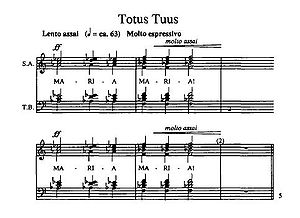
Totus Tuus (Górecki)
Encyclopedia

Opus number
An Opus number , pl. opera and opuses, abbreviated, sing. Op. and pl. Opp. refers to a number generally assigned by composers to an individual composition or set of compositions on publication, to help identify their works...
. 60 (English: Totally Yours
Totus Tuus
Totus Tuus was Pope John Paul II's apostolic motto. It is a Latin phrase meaning "totally yours" and expressed his personal Consecration to Mary based on the spiritual approach of Saint Louis de Montfort and the Mariology in his works...
) was written for unaccompanied mixed choir by the Polish composer Henryk Górecki
Henryk Górecki
Henryk Mikołaj Górecki was a composer of contemporary classical music. He studied at the State Higher School of Music in Katowice between 1955 and 1960. In 1968, he joined the faculty and rose to provost before resigning in 1979. Górecki became a leading figure of the Polish avant-garde during...
in 1987. Górecki composed the piece to celebrate Pope John Paul II
Pope John Paul II
Blessed Pope John Paul II , born Karol Józef Wojtyła , reigned as Pope of the Catholic Church and Sovereign of Vatican City from 16 October 1978 until his death on 2 April 2005, at of age. His was the second-longest documented pontificate, which lasted ; only Pope Pius IX ...
's third pilgrimage to his native Poland that summer, and the work remains his best-known, if not critically acclaimed, a cappella
A cappella
A cappella music is specifically solo or group singing without instrumental sound, or a piece intended to be performed in this way. It is the opposite of cantata, which is accompanied singing. A cappella was originally intended to differentiate between Renaissance polyphony and Baroque concertato...
choral piece of the 1980s. The work was first performed in on June 14, 1987 at a High Mass
High Mass
High Mass may mean:*Solemn Mass, a Tridentine Mass celebrated with deacon and subdeacon *Missa Cantata, a sung Tridentine Mass without deacon and subdeacon...
held in Victory Square, Warsaw by the Choir of the Warsaw Academy of Catholic Theology.
The libretto was taken from a poem written by contemporary writer Maria Boguslawska which is addressed to the Virgin Mary, the patron saint of Poland. Totus Tuuss form is ABA'CD, and marks a return to the simple homophony
Homophony
In music, homophony is a texture in which two or more parts move together in harmony, the relationship between them creating chords. This is distinct from polyphony, in which parts move with rhythmic independence, and monophony, in which all parts move in parallel rhythm and pitch. A homophonic...
characteristic of Górecki's earlier Marian Songs. The composition's texture
Texture (music)
In music, texture is the way the melodic, rhythmic, and harmonic materials are combined in a composition , thus determining the overall quality of sound of a piece...
utilises homophony to allow for a clear voice for the libretto, while the simple chant form is repeated to slowly build a musical affirmation of faith. Gorecki used a homophonic texture in other Marian compositions such as 1985's Marian Songs, Op. 54, and Under your Protection, Op. 56. This simplification of texture also occurs in Gorecki's most famous work, Symphony No. 3
Symphony No. 3 (Górecki)
The Symphony No. 3, Op. 36, also known as the Symphony of Sorrowful Songs , is a symphony in three movements composed by Henryk Górecki in Katowice, Poland, between October and December 1976. The work is indicative of the transition between Górecki's dissonant earlier manner and his more tonal...
, where a similarly simple, diatonic language is employed to evoke the sparse and repetitive mood of Holy minimalism
Holy minimalism
Holy minimalism, mystic minimalism, spiritual minimalism, or sacred minimalism are terms used to refer to a number of late-twentieth-century composers of Western classical music, whose works are distinguished by a minimalist compositional aesthetic and a distinctly religious or mystical subject...
.
Sources
- Thomas, Adrian. 1997. Górecki. Oxford Studies of Composers. Oxford: Clarendon Press; New York: Oxford University Press. ISBN 0-1981-6393-2
External links
- Performance by the University of Nottingham's Music Society "Mussoc"
- Performance by the Choir of New College, OxfordNew College, OxfordNew College is one of the constituent colleges of the University of Oxford in the United Kingdom.- Overview :The College's official name, College of St Mary, is the same as that of the older Oriel College; hence, it has been referred to as the "New College of St Mary", and is now almost always...

